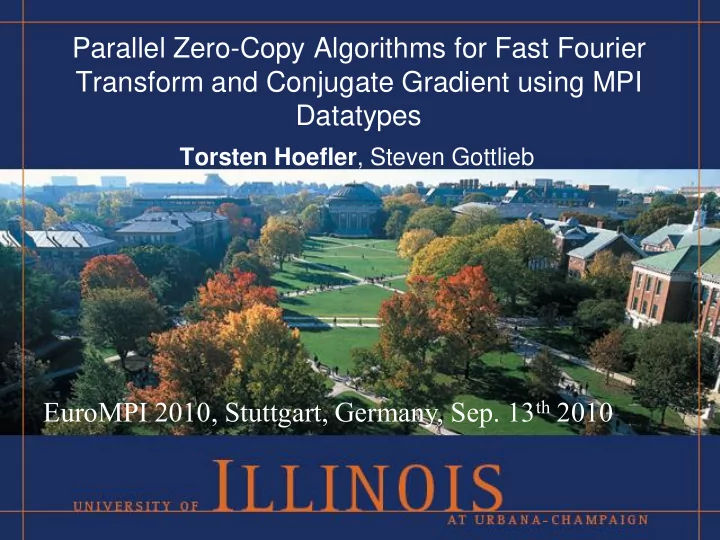

Parallel Zero-Copy Algorithms for Fast Fourier Transform and Conjugate Gradient using MPI Datatypes Torsten Hoefler , Steven Gottlieb EuroMPI 2010, Stuttgart, Germany, Sep. 13 th 2010
Quick MPI Datatype Introduction • (de)serialize arbitrary data layouts into a message stream – Contig., Vector, Indexed, Struct, Subarray, even Darray (HPF-like distributed arrays) • Recursive specification possible – Declarative specification of data-layout • “what” and not “how”, leaves optimization to implementation ( many unexplored possibilities!) – Arbitrary data permutations (with Indexed)
Datatype Terminology • Size – Size of DDT signature (total occupied bytes) – Important for matching (signatures must match) • Lower Bound – Where does the DDT start • Allows to specify “holes” at the beginning • Extent – Size of the DDT • Allows to interleave DDT, relatively “dangerous”
What is Zero Copy? • Somewhat weak terminology – MPI forces “remote” copy • But: – MPI implementations copy internally • E.g., networking stack (TCP), packing DDTs • Zero-copy is possible (RDMA, I/O Vectors) – MPI applications copy too often • E.g., manual pack, unpack or data rearrangement • DDT can do both!
Purpose of this Paper • Demonstrate utility of DDT in practice – Early implementations were bad → folklore – Some are still bad → chicken+egg problem • Show creative use of DDTs – Encode local transpose for FFT • Create realistic benchmark cases – Guide optimization of DDT implementations
2d-FFT State of the Art
2d-FFT Optimization Possibilities 1. Use DDT for pack/unpack (obvious) – Eliminate 4 of 8 steps • Introduce local transpose 2. Use DDT for local transpose – After unpack – Non-intuitive way of using DDTs • Eliminate local transpose
The Send Datatype 1. Type_struct for complex numbers 2. Type_contiguous for blocks 3. Type_vector for stride • Need to change extent to allow overlap (create_resized) – Three hierarchy-layers
The Receive Datatype – Type_struct (complex) – Type_vector (no contiguous, local transpose) • Needs to change extent (create_resized)
Experimental Evaluation • Odin @ IU – 128 compute nodes, 2x2 Opteron 1354 2.1 GHz – SDR InfiniBand (OFED 1.3.1). – Open MPI 1.4.1 (openib BTL), g++ 4.1.2 • Jaguar @ ORNL – 150152 compute nodes, 2.1 GHz Opteron – Torus network (SeaStar). – CNL 2.1, Cray Message Passing Toolkit 3 • All compiled with “ -O3 – mtune=opteron ”
Strong Scaling - Odin (8000 2 ) Reproducible peak at P=192 Scaling stops w/o datatypes • 4 runs, report smallest time, <4% deviation
Strong Scaling – Jaguar (20k 2 ) Scaling stops w/o datatypes DDT increase scalability
Negative Results • Blue Print - Power5+ system – POE/IBM MPI Version 5.1 – Slowdown of 10% – Did not pass correctness checks • Eugene - BG/P at ORNL – Up to 40% slowdown – Passed correctness check
Example 2: MIMD Lattice Computation • Gain deeper insights in fundamental laws of physics • Determine the predictions of lattice field theories (QCD & Beyond Standard Model) • Major NSF application • Challenge: – High accuracy (computationally intensive) required for comparison with results from experimental programs in high energy & nuclear physics 14 Performance Modeling and Simulation on Blue Waters
Communication Structure • Nearest neighbor communication – 4d array → 8 directions – State of the art: manual pack on send side • Index list for each element (very expensive) – In-situ computation on receive side • Multiple different access patterns – su3_vector, half_wilson_vector, and su3_matrix – Even and odd (checkerboard layout) – Eight directions – 48 contig/hvector DDTs total (stored in 3d array)
MILC Performance Model • Designed for Blue Waters – Predict performance of 300000+ cores – Based in Power7 MR testbed – Models manual pack overheads >10% pack time • >15% for small L
Experimental Evaluation • Weak scaling with L=4 4 per process – Equivalent to NSF Petascale Benchmark on Blue Waters • Investigate Conjugate Gradient phase – Is the dominant phase in large systems • Performance measured in MFlop/s – Higher is better
MILC Results - Odin • 18% speedup!
MILC Results - Jaguar • Nearly no speedup (even 3% decrease)
Conclusions • MPI Datatypes allow zero-copy – Up to a factor of 3.8 or 18% speedup! – Requires some implementation effort • Tool support for datatypes would be great! – Declaration and extent tricks make it hard to debug • Some MPI DDT implementations are slow – Some nearly surreal – We define benchmarks to solve chicken+egg problem
Acknowledgments & Support • Thanks to • Bill Gropp • Jeongnim Kim • Greg Bauer • Sponsored by
Backup Backup Slides
2d-FFT State of the Art
Recommend
More recommend